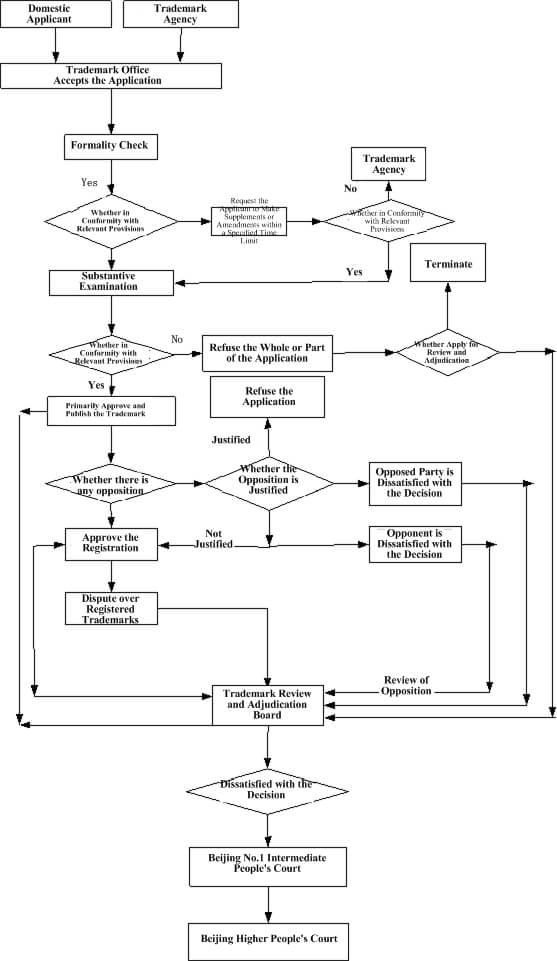Contents
Introduction:
Registering a trademark in China is critical for any company that has plans to operate in China or is already functional there. They need to know the necessity of registering a Chinese trademark and the process of doing the same. This article provides insight into why it is important to register a trademark in China and how to go about securing it.
Meanwhile, registering a Chinese trademark is essential for any company that wants to do long-term and profitable business in China. It provides them protection against trademark infringement and counterfeiting which is common in China. The companies need a registered trademark in China for licensing and selling their products in the country. Therefore, registering a trademark in China offers plenty of benefits to companies. Below are some important reasons for registering a Chinese trademark:
Protection Against Infringement and Illegal Use: Registering a trademark in China
The single most important purpose of registering a Chinese trademark is to prevent counterfeiting of the brand and products. If there is no registered trademark in China, then anyone can replicate the product and sell it as a fake. This erodes the brand credibility and causes considerable loss to the businesses. By registering a trademark, the brand instills confidence among the customers that they are purchasing only the original product. If the brand registered the trademark overseas but not in China, and the trademark squatters registered the trademarks. In this case, they can only threaten such brands for the seizure of their products based on trademark infringement.
Not registering a trademark in China exposes brands to significant risks of brand erosion and loss of business which is why registering a Chinese trademark is a must for them.
Make Use of E-commerce: How to choose theTrademark Registration in China
If any company wants to sell its products on e-commerce, it needs to register the trademark in China as most e-commerce players will ask for the same. With a rapidly expanding online marketplace, selling products on Chinese e-commerce platforms can enhance the visibility of the brand and add considerably to the profit. In addition to this, if the companies have trademarks, they can remove listings from the Chinese e-commerce websites when the product is being sold with another brand name. The e-commerce websites can quickly take down such malicious listings which will protect the brand and reduce monetary loss to the business.
Licensing Products to Distributors: Registration Trademark in China
Under the China Trademark Law, any company that plans to sell products in China under the existing brand name needs to own the trademark of the product. That is to say, if the company does not own the brand name in China then it cannot sell those products in the country.
According to the law, the company cannot license the products which it does not own to a distributor for selling. If so, any reputed distributor will insist on registering the trademark in China. In some cases, dubious distributors may even register the trademark on behalf of the company without telling them, which can create more issues. Therefore, best for the companies to register their trademark in China and then license the products to the distributors for selling.
Selling Products – Any brand register the Trademark in China
China is one of the largest global markets in the world. Certainly, most companies and brands have it on their priority to tap the immense and robust Chinese market. However, securing a Chinese trademark is essential for any company looking to sell its products in China for the long term. Any company which is selling branded products in China without a registered trademark may face precarious situations. There is a high chance that someone else will secure a trademark for their brand and then sue the original brand only for trademark infringement. Hence, it is highly recommended that any brand register the trademark in China and they also need to register the Chinese language equivalent of the trademark.
Legal Action of China Against Counterfeiters – Trademark Registration
One obvious advantage of registering a Chinese trademark is it allows the applicant to take legal action against anyone who does counterfeiting of the original products of the company. If a company does not have a registered Chinese trademark, then it can do nothing about counterfeiters. Moreover, it cannot take them to a court of law as they lack any ownership rights over the trademark.
If the truth is like this, it will only encourage such counterfeiters and cause further damage to the brand and profitability of the company. Thus, it is in the best interest of the companies to register for and secure a Chinese trademark to guard against counterfeiting of their products in the country.
The Process of Trademark Registration in China
The process of applying for the trademark application in China and getting the same approval is lengthy. It is better if the applicants start planning for the same and apply for a Trademark at the earliest. The applicant can register the trademark either through the CTMO or the WIPO. As China practices the first-to-file policy, it means the applicant who files the trademark registration application first is preferred and awarded the trademark. Such applicants will also get the rights to distribute and sell the product in the country for which the trademark application was made.
The detailed process for applying for registering a Trademark in China is provided below:
Select the Right System to File
There are two systems to file trademark applications in China. It can either be filed directly at the China Trademark Office (CNIPA) or by filing an application via the World Intellectual Property Organization (WIPO). Accordingly, the applicants should select the right channel for filing of Trademark to get the successful process at the earliest. If Foreign companies and applicants without any residency or place of business in China, need to apply for their trademark applications through a registered agent in China.
The process of direct application with CTMO has greater benefits compared to filing with the WIPO. Application through CTMO provides more flexibility and control to the applicant as they can decide for which classes are to be filed and what type of products and services are to be covered by the trademark. Because some of the categories under the International Classification (Nice Agreement) have been further broken down into subcategories, it is a significant advantage for the applicants.
In fact, filing for a trademark under the WIPO route, the applicant does not decide which subclasses to apply for. Instead, it will be decided by the examiner, and which subclasses will be covered is based on their discretion.
Check the Availability of Trademark in China
The applicants are recommended to do a thorough pre-filing search to check the availability of the trademark. The pre-filing search is done by China Trademark Office and is generally completed in 1 day. Some agencies can do the pre-filing search for applicants free of charge.
Trademarks are approved and issued on a first-come, first-served basis in China. This means that if a trademark has been registered prior by someone then it will not be awarded to any later applicant.
As a matter of fact, if there are two applicants who filed the trademark registration on the same day, the first applicant will receive the preference for registration. The result is that the pre-filing search will save considerable effort and resources later.
Choose the Correct Product and Service Sub-Classes
Like most countries, China follows the International Classification under Nice Agreement. However, it is important to note that these classes are further segregated into smaller subclasses in China. The applicants should carefully study and understand the subclasses they want to be covered under their trademark registration application. For example, general footwear and boots will fall into different subclasses in China and the same trademark may have been registered by different companies in each of these subclasses. Therefore, the applicants should ensure that the trademark covers all the products and services in each of the subclasses which is relevant to them.
Chinese Translation of Trademark Registration
Trademarks registered in Roman characters do not protect them from being registered or infringing similar Chinese trademarks. Hence, it is recommended to register a Chinese version of the trademark to remove any ambiguity and prevent unscrupulous elements from taking advantage of the situation and using the registered trademark.
Registration of trademarks in Chinese Simplified characters is difficult though. This is mostly due to the fact that translation or transliteration into Chinese does not make sense always.
For example, Ralph Lauren did not create a Chinese trademark when doing business in the country. While Ralph Lauren discovered that their brand was known as “San Jiao Ma” in China, which translates as “three-legged horse”.
So, choosing a Chinese trademark is further important as the meaning, pronunciation, or even the look of the Chinese characters can have an impact on the business.
Submission of Trademark Relevant Documents in China
The company applying for registering a Chinese trademark needs to prepare and submit the documents required by the relevant authorities. In China, the National Intellectual Property Administration (CNIPA) is responsible for managing all trademark registration processes and applications.
The company must comply with the prescribed documents and forms when submitting a trademark registration application. It is important to verify the documents for any errors or incompleteness before submission. In other words, the documents should also be verified for adhering to the correct format as prescribed by the authorities.
Verification and Approval by CNIPA:
Once the applicant submits the forms, CNIPA verifies each of the submitted documents. Based on its verification, CNIPA will probably recommend the applicant provide further documents to move ahead with the trademark registration process. Once CNIPA has completed the document verification, it starts the process of registering the trademark. Generally, the verification process is lengthy and takes at least one year.
Approval and Issue of Trademark
Under the process of registering the trademark, CNIPA goes ahead with the approval and issue of the announcement to the public. Normally, the process of trademark announcement takes 3 months from the time of completion of the verification process. During that period, anyone could object to the trademark legally.
Receipt of Trademark Certificate
If there’s no objection to the trademark announcement, CNIPA will send the certificate of approval to the applicants. In summary, the applicant can expect 6 months to receive the Electronic Trademark certificate from the date of the trademark application.
New Policy about Trademark Registration Time in China
CNIPA released a new policy to shorten the Trademark approval Time on January 1, 2019. The key points of the notice are provided below:
- CNIPA has shortened the formal verification period from two months to one month.
- The substantive verification period has been shortened from eight months to six months.
- The period for the verification of trademark assignment has been shortened from six months to four months.
- The time for trademark registration amendment and term renewal has been shortened from three months to two months.
The registered trademarks in China can consist of words, designs, letters, numbers, 3D symbols, a combination of colors, etc. However, it is best to avoid the names of cities and Chinese dignitaries whether of the past or the present.
The validity: To Register a Trademark in China
The details of the new rates for CNIPA are provided below:
| S. No |
Particulars |
Fee (RMB) |
| 1 | Applying for trademark per class | 300 |
| 2 | Designating each additional item of goods/services over the basic ten per class | 30 |
| 3 | Applying for re-issuance of a registration certificate | 500 |
| 4 | Applying for assignment/transfer of a trademark registration/application | 500 |
| 5 | Applying for renewal of a registration per class | 1000 |
| 6 | Late filing of renewal documents per class during the grace period | 250 |
| 7 | Appeal procedures before the Trademark Review & Adjudication Board (TRAB) | 750 |
| 8 | Recording change of name or address or agent of the owner for mark per class | 250 |
| 9 | Obtaining a certified document | 50 |
| 10 | Applying for collective or certification mark per class | 1500 |
| 11 | Filing an opposition per mark per class | 500 |
| 12 | Cancellation procedures per mark per class | 500 |
| 13 | Applying for records of a license | 150 |
Conclusion:
If you want to register a Trademark in China, firstly, you can use the Free Trademark Search Engine and check the trademark classification in China. Secondly, our Trademark Registration Attorney will check the availability of the trademark and provide you with a professional suggestion.
The key point is that Chinese trademark registration is valid for 10 years. The applicants need to apply for renewal of the trademark at least 6 months before its expiry. Consequently, they need to renew again the trademark for 10 years.
In addition, it is important to note that if the applicant doesn’t use the product for commercial purposes within 3 years of getting the trademark. If so, the company may stand the risk of losing the registered trademark.



